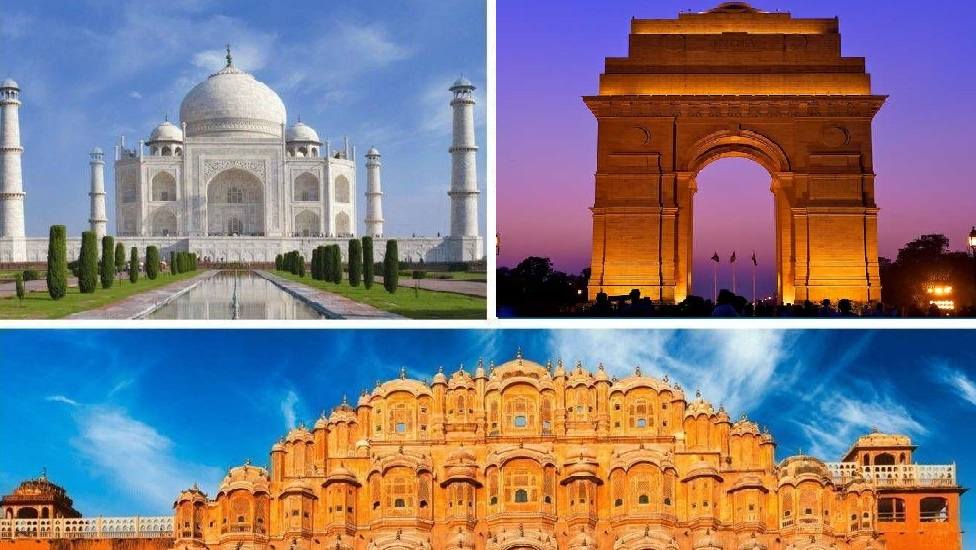India’s famed Golden Triangle circuit—connecting Delhi, Agra, and Jaipur—is a treasure trove of photogenic spots that captivate travelers from around the world. This triangular route provides an authentic glimpse into the country's rich history, architectural wonders, and vibrant culture. For photography enthusiasts, each destination offers a unique canvas of colors, patterns, and timeless heritage. Here’s a guide to the most picturesque places across the Golden Triangle that foreign tourists often find irresistible.
The Majestic Taj Mahal, Agra
No visit to the Golden Triangle is complete without witnessing the ethereal beauty of the Taj Mahal. This 17th-century marble mausoleum, built by Mughal Emperor Shah Jahan, draws visitors for its perfect symmetry, intricate inlay work, and the romantic story behind its creation. Photographers from all over the world are enchanted by how the monument’s color changes at sunrise, sunset, and under the moonlight. The reflection of the Taj Mahal in the long pool leading up to its entrance is a classic shot that adorns countless travel albums.
Amber Fort, Jaipur
Set atop a rugged hill overlooking Maota Lake, Amber Fort is a masterpiece of Rajput architecture that offers plenty of photographic opportunities. The ornate gateways, expansive courtyards, and mirror-adorned halls provide striking compositions for every lens. The fort’s honey-hued sandstone walls glow beautifully during the golden hours of sunrise and sunset, making it a favorite subject for foreign photographers seeking dramatic landscapes and detailed close-ups of ancient craftsmanship.
Humayun’s Tomb, Delhi
Humayun’s Tomb in Delhi is a UNESCO World Heritage site that predates the Taj Mahal and inspired its design. Its Persian-style gardens, arched doorways, and red sandstone exterior make it one of the most photogenic sites in the capital. Visitors often frame their shots with the lush greenery or capture the play of light and shadow on its intricate façade. The symmetry of the monument and its serene setting provide endless possibilities for compelling photographs.
City Palace, Jaipur
A striking blend of Mughal and Rajasthani architecture, the City Palace of Jaipur invites photographers to explore its courtyards, gateways, and ornate chambers. The famous Pritam Niwas Chowk, with its four beautifully painted seasonal gates, is a favorite spot for capturing vibrant colors and intricate designs. Each corner of this palace complex tells a story, offering visual narratives that appeal to foreign travelers eager to document India’s royal heritage.
Jama Masjid, Delhi
One of the largest mosques in India, Jama Masjid stands as a testament to Mughal architectural excellence. The vast courtyard, towering minarets, and detailed marble domes create powerful compositions for photography. The mosque’s elevated position also offers panoramic views of Old Delhi’s bustling streets, making it a dual attraction for those interested in both architectural and street photography.
Hawa Mahal, Jaipur
The iconic Hawa Mahal, or Palace of Winds, is instantly recognizable for its unique honeycomb façade dotted with 953 small windows. Built in 1799, this structure was designed to allow royal women to observe city life without being seen. Today, it stands as one of Jaipur’s most photographed landmarks, especially at dawn when the pink sandstone glows softly under the morning sun. Visitors often capture the façade from across the street to showcase its full grandeur.
Agra Fort, Agra
Often overshadowed by the Taj Mahal, Agra Fort is another stunning site that photographers love. The massive red sandstone walls enclose a complex of palaces, mosques, and audience halls, each with unique details worth capturing. The view of the Taj Mahal from Agra Fort’s Musamman Burj is particularly sought after, offering a framed glimpse of the famous monument through a historic lens.
Qutub Minar, Delhi
The Qutub Minar, standing at 73 meters, is the tallest brick minaret in the world. Its towering height, ornate balconies, and detailed carvings provide endless angles for creative photography. The surrounding ruins of ancient mosques and tombs within the Qutub complex add to the photogenic appeal of the site. Visitors often experiment with perspectives, capturing the minaret framed by archways or reflected in puddles after rain.
Ranthambore National Park (Extension for Wildlife Photography)
For those who wish to combine heritage with nature, exploring the Golden Triangle Tour With Ranthambore offers exceptional wildlife photography. Located near the Golden Triangle route, Ranthambore National Park is known for its tiger sightings, scenic lakes, and ancient fort ruins. Foreign tourists often delight in capturing images of Bengal tigers, leopards, and diverse bird species against the dramatic backdrop of the Aravalli hills.
Varanasi Ghats (Cultural Extension)
Many travelers enhance their journey by adding Varanasi to their itinerary through the Golden Triangle Tour with Varanasi. The ghats of Varanasi along the Ganges River present vibrant scenes of devotion, rituals, and daily life. From the soft morning light illuminating boatmen on the river to the dramatic evening Ganga Aarti, Varanasi offers unparalleled opportunities for cultural photography.
Final Thoughts
The Golden Triangle Tour is not only a journey through India’s most iconic cities but also a photographer’s dream route. From majestic forts to sacred rivers, each destination offers foreign visitors countless chances to capture India’s spirit in timeless frames. Whether exploring grand monuments or hidden corners, travelers return home with memories etched in photographs that tell the story of this incredible land.
